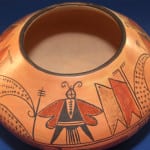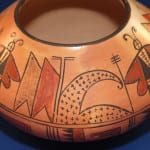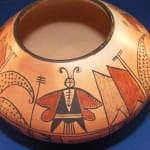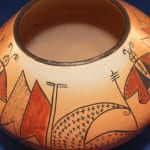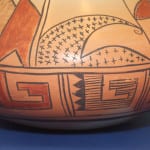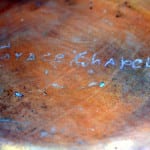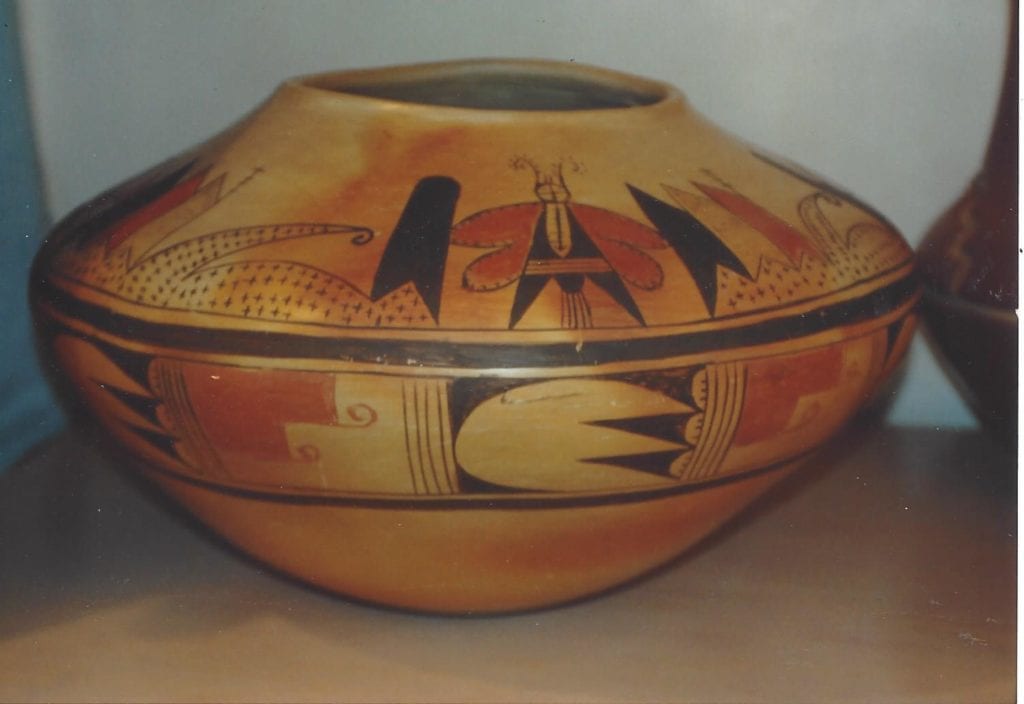The design on pot 2010-10 is the iconic Grace Chapella design. The 1977 catalog of a pottery exhibit held in her honor shows her holding such a pot (Collins 1977:9). On the website of the collection I publish a photograph of a Grace Chapella pot with this same design owned by Rick Dillingham. I took the photograph in his home on 5/17/93. This same pot is published in Rick’s book Fourteen Families in Pueblo Pottery (1994:5). After she suffered a stroke in 1974 Grace no longer painted her own pottery. Presumably jar 2010-22 was made before that date.
Notice that the signature appears to have been scratched into the bottom, not painted. Deborah Neal of Old Territorial Shop (based on an occasional practice by Maria of San Ildefonso Pueblo) suggests that Grace simply forgot to sign the pot before firing and (perhaps at the request of the buyer) the signature was added later.
The design on 2010-22 is adapted directly from a Sikyatki pot excavated by Jesse Fewkes in 1895 and published in the 17th Annual Report of the Bureau of American Ethnology (Fewkes 1898). He called this design “the most beautiful of all the butterfly designs” and reprints a lateral view in color and a drawing of a top view. He wrote:
“The elaborate decoration of the zone outside the six butterflies is made up of feathers arranged in three clusters of three each, alternating with key patterns, crosshatched crooks, triangles, and frets. The wealth of ornament on this part of the vase is noteworthy, and the interpretation very baffling. This vase may well be considered the most elaborately decorated in the whole collection from Sikyatki (1898:678-680; 1974:54-56).”
Twenty-one years later, in the 33rd Report of the Bureau, Fewkes returned to the great butterfly vase. Without discussion, as a 1.5 page foldout, he reprints a 9-inch wide black and sepia drawing of the top of the vase (1919:preceding p. 277). For a different Sikyatki jar with a similar design, see Jacka, 1988:7.
What Grace Chapella has done is directly adopt and adapt elements of design from this Sikyatki pot. Although Fewkes call the design “very baffling,” and one should be cautious about trying to understand the mind of an ancient potter (see catalog discussion for 1997-05), the general meaning of the butterfly design seems clear. Kelly Hays-Gilpin and Emory Sekaquaptewa discuss the Hopi term” siitalpuva” which they define as “along (or throughout) the flowery land. Along the fields in bloom, the land brightened with flowers, as a place that shines forth with colored blossoms, birds and butterflies” (2006:14). That is the scene painted on jar 2010-22.
A Sikyatki jar with this design (though not Fewkes’ “great butterfly jar”) is illustrated in a 2006 Plateau Magazine article. Kelly Hays-Gilpin wrote the description: “Sikyatki Polychrome jar depicting the Uto-Aztecan ideal of the beauty of fertility and life” (Sekaquaptewa and Washburn 2006:45). In other words, siitalpuva.
I had a chance to discuss this design with Mark Tahbo at the Hopi Market at the Museum of Northern Arizona in July 2007. When Mark was in his mid-20’s and establishing himself as a potter, he made many versions of the design on 2010-22. “I became sick of doing it,” he said with a slight smile, “It was my great grandmother’s design.” Two such early pots by Mark are in this collection; see 1995-01 and 1997-08.
Mark interprets the two pointed elements on bowl 2010-22 as representing the Hopi mesas. The crosshatched wave image represents cornfields surrounded by water, the butterflies the burst of life after spring rains. The vertical lines with cross hatchings represent prayer feathers (pathos) suspended from a string (nakwakwoci), the typical prayer offerings for rain at Hopi. The frets in the lower band represent flowing water, their stepped edges are rain clouds. The design is siitalpuva, a land brightened with flowers: Hopi heaven on earth.
Such explanation of meaning by pueblo potters can be “post hoc,” the making up of plausible explanations for designs that have no intrinsic meaning. Potters do this to please tourists who insist that all designs must have meaning. I do not believe this is the case here. Whatever the meaning assigned to the design by the Sikyatki potters who created it 600 years ago, the meaning attached to the design today seems both real to the potter and deeply rooted in Hopi and Hopi/Tewa culture.
Grace was born on February 4, 1874 at Tewa Village (Hano), First Mesa, AZ, the daughter of Poui and Toby White. She was two years old when Custer made his Last Stand at the Battle of Little Big Horn and eight years old when the U.S. government established the Hopi reservation, in 1882. She was a neighbor of Nampeyo who was 14 years older than Grace, knew Nampeyo well, and perhaps was instructed by her. She died in June 1980,a long and productive life. For more details of her life, see the catalog entry for 1991-10.
Grace was married to John Mahkewa, with who she had two children. None of these descendants appears to be involved with pottery making. She also had an affair with Tom Pavatea and had a child by him, though they were never married. Tom established a flourishing trading pot in the village of Polacca and was frequently an intermediary between local residents and the Anglo world. (See Smith 1938.) The child of Grace and Tom, Alma Tahbo, was an accomplished potter and the mother of Deanna Tahbo and the grandmother of Mark, Dianne and Pamela Tahbo. All of these descendants of Alma became well-known potters and most are represented in this collection. (See the Artist List.)
There are many pots in this collection that depict butterflies. (See the Category List.) One in particular is especially close in design and spirit to Fewkes’ “great butterfly jar.” See 1989-01 by Marcella Kahe.
Pot 2010-22 is one of a group of pots that were part of a 2,400 item Southwest pueblo pottery collection that was assembled by Rutt Bridges of Denver, CO over a period of about 14 years. His sister, Kathleen Hoff, is helping her brother sell the collection. In 2009 Kat sent me two CDs with information about Hopi pots in the collection. During 2010, over a period of months Kay sent me additional photographs of about 200 Hopi and Hopi/Tewa pots from the collection.


